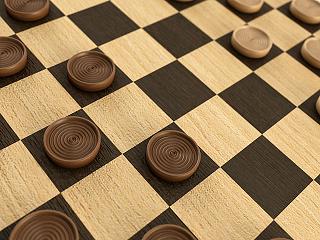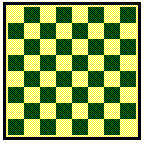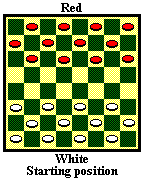 Rules of the game: Checkers.
Rules of the game: Checkers.

 Rules of the game: Checkers.
Rules of the game: Checkers.

To move a piece, you can do it in two different ways.
Remember you can set the clock parameters in the game options.
Rules of the game:
 The game board is square, with sixty-four smaller squares,
arranged in an 8x8 grid. The smaller squares are alternately light and dark
colored (green and buff in tournaments), in the famous "checker-board" pattern.
The game of checkers is played on the dark (black or green) squares.
Each player has a dark square on his far left and a light square on his far
right. The double-corner is the distinctive pair of dark squares in the near
right corner.
The game board is square, with sixty-four smaller squares,
arranged in an 8x8 grid. The smaller squares are alternately light and dark
colored (green and buff in tournaments), in the famous "checker-board" pattern.
The game of checkers is played on the dark (black or green) squares.
Each player has a dark square on his far left and a light square on his far
right. The double-corner is the distinctive pair of dark squares in the near
right corner.
 The pieces are Red and White, and
are called Black and White in most books. In some modern publications, they are
called Red and White. Sets bought in stores may be other colors. Black and Red
pieces are still called Black (or Red) and White, so that you can read the
books. The pieces are of cylindrical shape, much wider than they are tall (see
diagram). Tournament pieces are smooth, and have no designs (crowns or
concentric circles) on them. The pieces are placed on the dark squares
of the board.
The pieces are Red and White, and
are called Black and White in most books. In some modern publications, they are
called Red and White. Sets bought in stores may be other colors. Black and Red
pieces are still called Black (or Red) and White, so that you can read the
books. The pieces are of cylindrical shape, much wider than they are tall (see
diagram). Tournament pieces are smooth, and have no designs (crowns or
concentric circles) on them. The pieces are placed on the dark squares
of the board.
 The
starting position is with each player having twelve pieces, on the twelve
dark squares closest to his edge of the board. Notice that in checker diagrams,
the pieces are usually placed on the light colored squares, for readability. On
a real board they are on the dark squares.
The
starting position is with each player having twelve pieces, on the twelve
dark squares closest to his edge of the board. Notice that in checker diagrams,
the pieces are usually placed on the light colored squares, for readability. On
a real board they are on the dark squares.
![]() Moving:
A piece which is not a king can move one square, diagonally, forward, as in the
diagram at the right. A king can move one square diagonally, forward or
backward. A piece (piece or king) can only move to a vacant square. A move can
also consist of one or more jumps (next paragraph).
Moving:
A piece which is not a king can move one square, diagonally, forward, as in the
diagram at the right. A king can move one square diagonally, forward or
backward. A piece (piece or king) can only move to a vacant square. A move can
also consist of one or more jumps (next paragraph).

 Jumping: You capture an opponent's piece (piece or king) by
jumping over it, diagonally, to the adjacent vacant square beyond it. The three
squares must be lined up (diagonally adjacent) as in the diagram at the left:
your jumping piece (piece or king), opponent's piece (piece or king), empty
square. A king can jump diagonally, forward or backward. A piece which is not a
king, can only jump diagonally forward. You can make a multiple jump (see the
diagram on the right), with one piece only, by jumping to empty square to empty
square. In a multiple jump, the jumping piece or king can change directions,
jumping first in one direction and then in another direction. You can only jump
one piece with any given jump, but you can jump several pieces with a move of
several jumps. You remove the jumped pieces from the board. You cannot jump
your own piece. You cannot jump the same piece twice, in the same move. If you
can jump, you must. And, a multiple jump must be completed; you cannot stop
part way through a multiple jump. If you have a choice of jumps, you can choose
among them, regardless of whether some of them are multiple, or not. A piece,
whether it is a king or not, can jump a king.
Jumping: You capture an opponent's piece (piece or king) by
jumping over it, diagonally, to the adjacent vacant square beyond it. The three
squares must be lined up (diagonally adjacent) as in the diagram at the left:
your jumping piece (piece or king), opponent's piece (piece or king), empty
square. A king can jump diagonally, forward or backward. A piece which is not a
king, can only jump diagonally forward. You can make a multiple jump (see the
diagram on the right), with one piece only, by jumping to empty square to empty
square. In a multiple jump, the jumping piece or king can change directions,
jumping first in one direction and then in another direction. You can only jump
one piece with any given jump, but you can jump several pieces with a move of
several jumps. You remove the jumped pieces from the board. You cannot jump
your own piece. You cannot jump the same piece twice, in the same move. If you
can jump, you must. And, a multiple jump must be completed; you cannot stop
part way through a multiple jump. If you have a choice of jumps, you can choose
among them, regardless of whether some of them are multiple, or not. A piece,
whether it is a king or not, can jump a king.
Kinging: When a piece reaches the last row (the King Row), it becomes a King. A second checker is placed on top of that one, by the opponent. A piece that has just kinged, cannot continue jumping pieces, until the next move.
Red moves first. The players take turns moving. You can make only one move per turn. You must move. If you cannot move, you lose. Players normally choose colors at random, and then alternate colors in subsequent games.